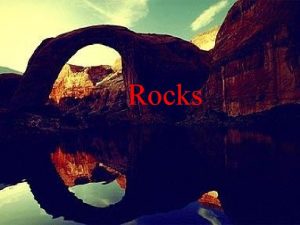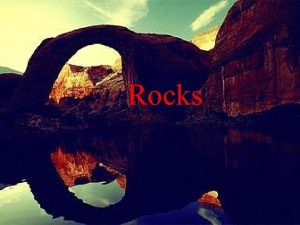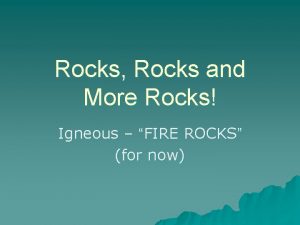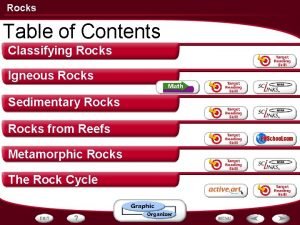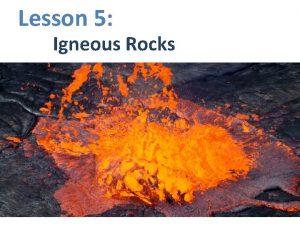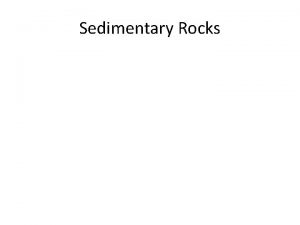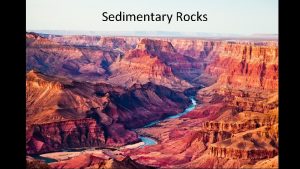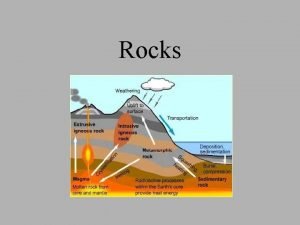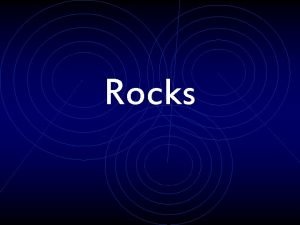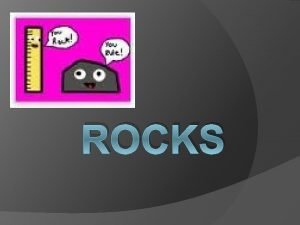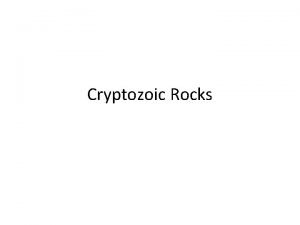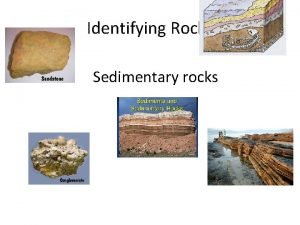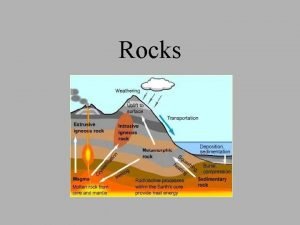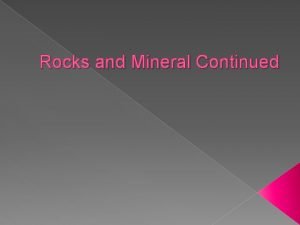Holiday for Everyday World Engineering Day III Rocks












































- Slides: 44

Holiday for Everyday World Engineering Day!

III. Rocks “Let’s Rock & Roll!”

A. Rocks 1. Modern Geology is said to have begun in 1795. James Hutton 2. Uniformitarianism a. “The present is the key to the past” b. The geologic processes now at work were also active in the past.

B. Three Groups of Rocks. 1. Rock- a group of minerals bound together in some way. a. order: Atoms, elements, compounds, minerals , rocks. 2. Rock classification a. Rock are Classified by 1. ) origin- when & where they were formed 2. ) composition- what makes them up

3. Types of Rocks a. Igneous (FIRE) 1. ) Rocks are formed by the cooling and hardening of hot molten rock from inside Earth. b. Sedimentary 1. ) Rocks formed by the hardening and cementing of layers of sediments. Come from other rocks. c. Metamorphic (Meta=change) 1. ) Are rocks that under go a change due to heat and pressure under ground.

Sedimentary Rocks Metamorphic rocks Igneous rocks

C. Igneous Rocks 1. Formation-occurs under the crust or at the crust 2. Types: a. Plutonic/intrusive Igneous rocks. 1. ) Form underground 2. ) seen at the surface only when the over lying rocks have been worn away. 3. ) larger crystal structure because of their slow cooling rate.

b. Volcanic/extrusive- form at or near the surface 1. ) very fast cooling rate. Crystal structure is hard to see. Igneous Rocks Into



Volcanic Plutonic Identify these as either volcanic or plutonic.

Magma & Lava Types thick, slow flowing very high in SILICA are called Felsic rocks. 1. ) Forms light colored rocks. hotter, thinner, low silica content Mafic rocks 1. )Produces dark colored rocks.

3. Textures a. the size, shape and arrangement of mineral crystals. b. how fast the magma cools c. Types of textures 1. ) Smooth grained texture: has no visible crystals. 2. ) Course Grained texture: Has visible crystal. 3. ) Glassy Texture. Has the appearance of glass. 4. ) Porferitic texture. Has two distinct crystal sizes. Due to two cooling rates.

Smooth Porferitic Course Glassy

4. Common Igneous rocks. • a. Granite 1). Course grained Igneous rock. Common rock in the rocky mtns. 2). Visible crystals 3). Composed of quartz , feldspar, hornblende, & biotite.

The addition of various minerals like olivine makes granite different colors.

Basalt 2. Basalta. Most common igneous rock. b. Forms at or near the surface by cooling lava and magma. c. Cools very quickly d. No visible crystals. Fine grained rock. e. Often has vesicles. Holes or voids in the rock where volcanic gasses were trapped by the solidifying material.


Rhyolite 3. Rhyolitea. Composed of the same light colored minerals b. Cools at or near the surface very quickly. c. Is fine-grained.


Obsidian 4. Obsidiana. Dark colored igneous rock however, has a composition similar to Granite. b. Cools very quickly at the surface. c. Glassy texture. d. Had many uses for Native Americans due to its unique way of breaking.


#3 Igneous Topic Questions 1. Describe the difference between intrusive and extrusive rocks. 2. Name & describe the FOUR types of rock textures. 3. Draw a detailed piece of granite (colored) & label the minerals that compose it. [pg. 95 red text] 4. Draw each igneous rock under the microscope (on pg. 96). Include a. name of rock b. type of texture c. type of lava d. one unique characteristic

Everyday is a Holiday! National Inventors Day!

G. Sedimentary Rocks 1. Rocks made of other rocks. 2. Three types: Clastic, Organic and Chemical.

3. How does sediment become rocks? a. Erosion- breaking up or wearing away rocks b. Deposition- sediment settles c. Compaction- sediments press together d. Cementation- minerals crystallize & glue rock together Pg. 103 red textbook


Big Horn Montana

4. Clastic sed. Rocks -a. Clasts are fragments of other rocks that range in size from boulders to silt and clay particles. - b. Clasts get stuck together by natural cements like silica or calcite they form clastic sedimentary rocks. -c. Ex. Shale, sandstone and conglomerate.


Clastic Sedimentary Rocks

5. Chemical Sed. Rocks -a. Sedimentary rocks are formed from mineral grains that fall out of a solution by evaporation or by chemical action. -b. Ex. Rock salt and limestone

Lake drying in the sun. Water evaporates and leaves the dissolved minerals behind creating chemical sedimentary rocks.

6. Organic Sedimentary Rocks a. formed from the remains of plants and animals. b. Ex. Coal and limestone made of shell fragments.

H. Fossils in Sedimentary Rocks 1. Fossils - Remains or impressions of plants and animals preserved in a rock. a. Sedimentary rocks are the only rock type that you will find fossils. As sediments pile up, animals and plants that die in the area are buried. The soft parts dissolve away and decay. The hard parts may remain as a fossil.


Sedimentary/Igneous Rock Topic Questions • In your comp book answer the following questions in complete sentence answers. • Sedimentary Rocks - Pg. 97, 1 -2 all. • Igneous Rocks - Pg. 101, 1 -2 all.

I. Metamorphic Rock a. Formation 1. ) All of the metamorphic rock are rocks that undergo some type of change due to intense heat and pressure. 2. ) The type of pressure needed to change a rock’s structure can only be achieved at great depths in the earth’s crust. b. Two types. -Regional and Contact Metamorphism. 1. ) Regional - Occurs when large areas of rock are under intense heat and pressure. Pressure squeezes their grains closer together. The squeezing makes them more dense and less porous. The heat and chemicals may rearrange the particles. Making lines and bands in the rocks.

2. ) Contact- This process occurs when hot magma forces its way into overlying rock. The heat of the magma bakes the rocks that are in contact with it.

Examples of metamorphic rocks and their origin rock.

Example: Formation of Gneiss • Forms when Granite or Conglomerate rock is changed.

J. Rock Cycle 1. Many pathways Ex. Granite is formed from magma Erosion, deposition, cementation becomes sandstone pressure & heat form quartzite


CBA: Rock Cycle & Rock Review 1. Copy the diagram from pg. 115 (red text) of the Rock Cycle, color the arrows to match the diagram 2. Reviewing Key Terms pg. 119 #’s 1 -6 3. Checking Concepts pg. 120 #’s 7 -12 4. Critical Thinking pg. 120 #s 17 -20
 Sedimentary igneous and metamorphic
Sedimentary igneous and metamorphic Compaction and cementation
Compaction and cementation Day 1 day 2 day 3 day 4
Day 1 day 2 day 3 day 4 Day 1 day 2 day 817
Day 1 day 2 day 817 Hamlet act iii scene iii
Hamlet act iii scene iii Intrusive vs extrusive igneous rocks
Intrusive vs extrusive igneous rocks Lasa naviance
Lasa naviance Holiday inn knoxville worlds fair park
Holiday inn knoxville worlds fair park Reinforcement in concrete
Reinforcement in concrete Iso 22301 utbildning
Iso 22301 utbildning Novell typiska drag
Novell typiska drag Nationell inriktning för artificiell intelligens
Nationell inriktning för artificiell intelligens Vad står k.r.å.k.a.n för
Vad står k.r.å.k.a.n för Shingelfrisyren
Shingelfrisyren En lathund för arbete med kontinuitetshantering
En lathund för arbete med kontinuitetshantering Personalliggare bygg undantag
Personalliggare bygg undantag Tidbok
Tidbok Anatomi organ reproduksi
Anatomi organ reproduksi Densitet vatten
Densitet vatten Datorkunskap för nybörjare
Datorkunskap för nybörjare Stig kerman
Stig kerman Att skriva debattartikel
Att skriva debattartikel För och nackdelar med firo
För och nackdelar med firo Nyckelkompetenser för livslångt lärande
Nyckelkompetenser för livslångt lärande Påbyggnader för flakfordon
Påbyggnader för flakfordon Lufttryck formel
Lufttryck formel Publik sektor
Publik sektor Lyckans minut erik lindorm analys
Lyckans minut erik lindorm analys Presentera för publik crossboss
Presentera för publik crossboss Jiddisch
Jiddisch Kanaans land
Kanaans land Treserva lathund
Treserva lathund Epiteltyper
Epiteltyper Claes martinsson
Claes martinsson Centrum för kunskap och säkerhet
Centrum för kunskap och säkerhet Lågenergihus nyproduktion
Lågenergihus nyproduktion Mat för idrottare
Mat för idrottare Verktyg för automatisering av utbetalningar
Verktyg för automatisering av utbetalningar Rutin för avvikelsehantering
Rutin för avvikelsehantering Smärtskolan kunskap för livet
Smärtskolan kunskap för livet Ministerstyre för och nackdelar
Ministerstyre för och nackdelar Tack för att ni har lyssnat
Tack för att ni har lyssnat Hur ser ett referat ut
Hur ser ett referat ut Redogör för vad psykologi är
Redogör för vad psykologi är Matematisk modellering eksempel
Matematisk modellering eksempel














































